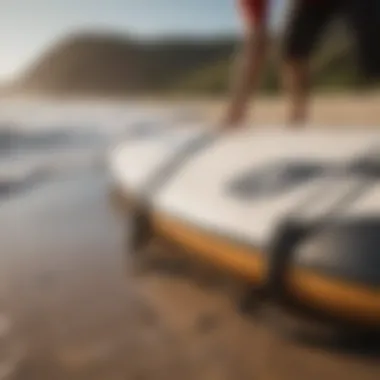Exploring the 8 Ft Surfboard Bag: Key Features and Tips


Intro
Surfing is more than a sport; it’s a way of life. For those who spend time riding the waves, protecting their equipment becomes paramount. This is where the 8 ft surfboard bag comes into play, serving as a crucial accessory for any surfer who values their board's longevity. The right bag doesn’t just protect; it enhances the overall surfing experience.
With numerous features, types, and materials on the market, understanding the options available is essential. This guide will not only highlight the key functionalities of these bags but also delve into maintenance tips and choosing the right fit for your specific needs. As we embark on this exploration of the 8 ft surfboard bag, we aim to equip readers with the information needed to make informed decisions about their gear.
Essential Techniques
Paddling Techniques
When you're out on the water, having the right technique in paddling can greatly influence the way your day unfolds. Paddling isn't just about arm strength; it's an art that combines technique and timing. Here are a few core elements:
- Body Positioning: Keep your body low and centered on the board to maintain stability.
- Efficient Stroke: Use long, smooth strokes, engaging both shoulders for maximum reach.
- Timing Waves: Paddle hard toward incoming waves, getting your board to catch the swell.
Understanding these basics helps surfers not only cut through the water but also build endurance and skill over time.
Safety Practices
Safety goes hand-in-hand with skill in the ocean. Always prioritize your safety and that of others around you. Keep in mind:
- Leash Check: Ensure your leash is secure to prevent losing your board.
- Awareness: Keep an eye on the surf conditions and be mindful of other surfers.
- Emergency Procedures: Learn how to handle wipeouts and navigate through currents.
Staying safe in the water is crucial for enjoying the surf without second-guessing your choices.
Gear Recommendations
Equipment Essentials
Choosing the right equipment is vital for any surfer. This includes not just the surfboard but a whole array of gear:
- Wetsuit: Depending on water temperature, a good wetsuit can make or break your surfing experience.
- Leash: Opt for a durable leash that suits your board size to avoid unwanted accidents.
- Boardsocks: When transporting your board in different conditions, boardsocks can add an extra layer of protection.
Focusing on these essentials helps in creating a safer environment not just for oneself but also for fellow beachgoers.
Choosing the Right Gear
Now, let’s discuss how to make the right selections:
- Size: Ensure that the surfboard bag fits your board snugly. An 8 ft bag needs to accommodate specific dimensions properly to avoid damage.
- Material: Prioritize durable materials that can withstand the elements. Look for options like padded nylon or reinforced fabrics for added security.
- Budget: Factor in your budget, but don’t compromise on quality—spending a little more can often save you in the long run with durability.
While it’s tempting to go for cheaper options, investing in a quality surfboard bag pays off in terms of protection and longevity of your gear.
"The right gear can be the difference between a good and an unforgettable surf day."
By arming yourself with the right information about the 8 ft surfboard bag and related essentials, you're one step closer to making a smart choice for your surfing adventures.
Prelude to Surfboard Bags
When it comes to surfing, your board is more than just equipment; it’s almost an extension of who you are. Thus, the world of surfboard bags stands as a critical element in preserving this essential gear. Surfboard bags are designed with one significant purpose—to protect your board from the elements, accidental damages, and the usual wear and tear that comes with life on the waves. This importance cannot be overstated, not just in keeping your board in shape for performance but also in ensuring its longevity.
The Significance of Surfboard Protection
Surfboards, especially those reaching 8 feet, require proper care to maintain their performance and integrity. The surf environment, with its saltwater, sun, and rough handling, takes a toll on the exterior of any surfboard. A well-crafted surfboard bag provides a barrier against the sun’s damaging UV rays, which can weaken materials over time. It also guards against scratches and dings from both transport and storage, which can drastically alter a board’s performance.
Moreover, for surfers who frequently travel or transport their boards, the risk of damage increases significantly. Relying on a surfboard bag means you have a safeguard in place against mishaps that might occur during transit. Ensuring your board remains safe means more fun in the water and less worry about potential repairs or replacements.
Overview of Ft Surfboard Bags
The 8 ft surfboard bag is a specific segment in the broader category of surfboard storage solutions. These bags are tailored for longboards or specific types of boards that benefit from extra length. A surfer with an 8 ft board faces unique challenges when it comes to protection and portability.
When choosing a surfboard bag, one must consider a few critical factors:
- Padding: An 8 ft bag should come with ample padding to absorb shocks—a must for travel.
- Material: Durability is vital. The fabric should withstand rough handling and resist elements like water and sun.
- Portability: Since an 8 ft board is rather bulky, effective straps and handles make all the difference when lugging it around.
- Storage: Many bags offer additional spaces for accessories, which can be a lifesaver when you’re heading out for a day at the beach.


Ultimately, investing in an 8 ft surfboard bag translates into a wise long-term decision, ensuring that your beloved board stays in peak condition and ready for action whenever the surf calls.
Understanding the Dimensions
When it comes to selecting an 8 ft surfboard bag, grasping the significance of dimensions cannot be overstated. The right size affects not just how well the bag fits your surfboard but also the level of protection it provides during transportation and storage. An ill-fitting bag may lead to unnecessary wear and tear, leaving your prized board vulnerable to damage.
Why Size Matters
Choosing the right size involves more than just picking something that fits. A bag that’s too tight can stress your board and create problems during transport—like cracking or warping. Conversely, if the bag is far too large, your equipment might shift around inside. Many surfers have been down that road, forgetting the importance of snug but not constrictive fit.
Some might think, "A bigger bag gives me more room," but that’s a common misconception. When sizing a surfboard bag, consider the board’s thickness, any attached fins, and even the type of padding in the bag. Getting it right enhances not only the bag's utility but also your overall surfing experience.
Defining the Ft Standard
When we talk about the 8 ft standard in surfboard bags, we are referring to bags designed to accommodate boards that measure exactly 8 feet in length. This length is common among longboarders and can vary significantly in width and thickness. A standard 8 ft surfboard bag typically allows for a bit of extra length—about 6 inches—to accommodate fins and other attachments comfortably.
When you're shopping for a bag, always double-check the manufacturer's specifications. Not all 8 ft bags are made equal; they can differ in terms of width and internal padding. It’s vitally important to measure your surfboard accurately and consult manufacturer’s guidelines to ensure an appropriate fit. Show it the respect it deserves, and your board will thank you in each wave you ride.
Types of Surfboard Bags
Understanding the types of surfboard bags is crucial for any surfer who’s serious about protecting their gear. Each type of bag comes with its own set of advantages and drawbacks, tailored to different surfing scenarios and preferences. Whether you’re a weekend warrior heading to your local break or a seasoned pro jetting off to exotic surf destinations, knowing the distinctions can save you headaches later on.
Soft Bags vs. Hard Cases
When it comes to surfboard bags, the choice often boils down to soft bags versus hard cases. Soft bags, made of flexible materials like nylon or polyester, are popular among many surfers due to their lightweight nature. They can be tossed in the back of a car without worry, making them easy to handle during travel.
Soft bags provide decent protection against minor dings. However, they’re not immune to damage. For boards that need a bit more care, hard cases offer superior protection. The rigid shell shields against impacts and potential falls, but the trade-off is weight and bulkiness.
When selecting between these two options, consider the following points:
- Portability: Soft bags are usually lighter and easier to carry.
- Protection Level: Hard cases generally offer better security for your surfboard.
- Cost: Soft bags are often more budget-friendly compared to hard cases, which can be a plus for casual surfers.
Single vs. Multi-board Bags
The next distinction in surfboard bags relates to how many boards can be comfortably accommodated. Single-board bags are tailored for those with just one main ride. They offer a snug fit, minimizing movement during transit, which is a boon for avoiding scratches and other wear and tear.
On the flip side, multi-board bags cater to the surfer who likes variety. They can hold multiple boards—good for those hitting various wave conditions or for a long surf trip where shifting styles is necessary. Here’s a deeper look:
- Single-board Bags: More streamlined, less weight. Perfect for day trips or short sessions.
- Multi-board Bags: Offers versatility but can feel bulky when not fully loaded. Suitable for extended excursions.
Travel vs. Day Bags
Lastly, understanding the differences between travel bags and day bags is key for planning your surfing adventures. Day bags are typically simpler and provide just enough protection for a quick trip to the beach. They often come without complex features but are lightweight, making them easy on the go.
In contrast, travel bags are built to endure the rigors of air travel or long distances. These bags usually feature additional padding, heavier materials, and better zippers to handle the journey.
Take note of these factors when deciding on the right type:
- Durability: Travel bags are crafted with sturdiness in mind, while day bags are more about ease of use.
- Weight: Day bags tend to be lighter, but a travel bag's added heft usually translates to better protection.
- Features: Travel bags might have extra compartments or straps, ideal for accommodating your travel needs.
Deciding on the right type of surfboard bag requires careful consideration of your surfing habits and needs. Whether you're tackling a few waves locally or embarking on a grand surfing voyage, choosing wisely will make all the difference in ensuring your board stays safe and sound.
Materials Used in Surfboard Bags
When it comes to the world of surfboard bags, the materials utilized play a pivotal role in determining the overall functionality, durability, and protection offered to the board. Selecting the right materials not only enhances the bag’s performance but also ensures longevity, making it an essential consideration for surfers who wish to protect their expensive gear.
Neoprene: Durability and Flexibility
Neoprene stands tall among the popular materials for surfboard bags. This synthetic rubber offers a balance of durability and flexibility that is hard to match. The fact is, neoprene can absorb shock, providing a cushy barrier that minimizes the risk of damage during transportation. It’s like wrapping your board in a soft, resilient hug.
Another key advantage is its resistance to water. While trips to the beach may be fun, wet conditions are inevitable for surfers. Neoprene's water-resistant properties keep the bag light and help in maintaining its structure without pulling the board down into mushy wetness, a benefit that cannot be overlooked. Many high-quality surfboard bags boast neoprene linings not just for cushioning but also for maintaining temperature control, keeping your board in optimum condition.
Nylon and Polyester: Common Choices
Nylon and polyester rank high as widely used materials in the construction of surfboard bags. These fabrics are tough and resilient, fashioning a protective outer layer that can withstand the rigors of travel. Imagine a backpack you can drag through sand and saltwater—these materials are designed to take a beating and still look good as new.


- Nylon is often lauded for its superior abrasion resistance, making it an ideal choice for both day-to-day use and longer journeys where wear and tear are concerns.
- Polyester, on the other hand, offers a blend of lightweight properties and water resistance, an ideal combo for marine life. It’s not just about what feels good in your hands; the ease of cleaning and maintenance makes polyester a preferred option for many surfers.
In essence, when choosing between nylon and polyester, ponder on the conditions in which you’ll be using the bag the most. If durability is a deciding factor, nylon might edge out polyester. However, if you need something that can tackle water challenges, polyester should be your go-to.
Impact-resistant Foam Padding
One cannot overlook the significance of impact-resistant foam padding in surfboard bags. This type of padding is like the defender standing guard, ensuring that your board remains unscathed in case of accidental drops or rough handling.
- Protection against impacts: Regardless of how careful you are, unexpected bumps can happen. This foam acts as a buffer, absorbing shocks and protecting sensitive areas of your surfboard.
- Temperature regulation: Some types of foam also help insulate your board from extreme temperatures, which can warp or damage the craft.
Put simply, good padding not only cushions but creates a protective cocoon around your board. When choosing a surfboard bag, look for those with ample foam padding that can offer layers of protection without compromising portability.
In summary, the materials used in surfboard bags are a crucial element that directly impacts protection and usability. Neoprene offers durability and flexibility, nylon and polyester present reliable toughness, while impact-resistant foam padding stands as a fort for your board against unexpected bumps and bruises. Choosing a bag crafted from high-quality materials is not merely a good idea; it’s a fundamental step toward ensuring the longevity of your surfboard and the enjoyment of countless surf sessions ahead.
Key Features to Consider
When selecting an 8 ft surfboard bag, there are numerous features that can significantly impact both the usability and longevity of the bag. Choosing a bag isn’t as simple as picking the one that looks good; it’s crucial to understand what functionalities might benefit you the most. With a variety of options on the market, focusing on key features ensures that you select a bag that not only protects but also complements your surfing lifestyle.
Padding and Protection Levels
Padding is arguably one of the most essential elements of a surfboard bag. The right amount can cushion the board against unexpected bumps and drops during transportation. A bag with high-density foam padding can make all the difference when it comes to preventing dings and damages, especially if you travel often. Many manufacturers promote bags with varying padding thicknesses. Generally speaking, the thicker the padding, the better protection you can expect. However, one must also balance weight and protection—thick padding adds weight, which can be a consideration if you're heading out for a surf trip.
"A well-padded surfboard bag is like a snug blanket for your board; it wards off the chills of travel mishaps."
Straps and Handles for Portability
It’s essential that your bag is easy to carry, especially when you’re managing your surf gear and possibly other belongings all at once. Look for bags equipped with adjustable shoulder straps and sturdy handles. A padded shoulder strap can ease the strain while moving from your vehicle to the beach. Some bags even have multiple grip handles which make it convenient to carry in various ways. Whether you're walking miles on a sand path or loading your gear into a vehicle, choose a bag that entails versatility in carrying options.
Storage Compartments and Pockets
Having sufficient storage space is a feature that many overlook but is quite important. Look for bags that offer compartments for small items like fins, wax, or even sunblock. Some bags come with exterior pockets, which can be very handy for keeping essentials at the ready. Additional zipped compartments ensure that even if you are in a rush, your items won’t get lost while you focus on the waves.
By analyzing these key features—padding, portability options, and storage compabilities—you can better determine which 8 ft surfboard bag best suits your needs. Taking the time to evaluate these details can protect your equipment effectively and enhance your surfing experience.
Maintenance and Care Tips
Keeping your 8 ft surfboard bag in top shape doesn’t just ensure its longevity; it also keeps your surfboard secure and ready for the waves. Maintenance may seem like a chore, but it's a crucial part of not just preserving the bag but also protecting your investment in surfing gear. A well-maintained surfboard bag can extend its life and ensure that it effectively guards against elements and possible damage.
Cleaning Your Surfboard Bag
Cleaning is the bedrock of maintenance. After all, nothing can last in a grungy state. Surfboards often come back from their watery adventures covered in salt, sand, and other debris. A surfboard bag that accumulates dirt and grime can lead to wear and tear, making it more difficult to properly protect the board.
- Rinse your bag with fresh water after every use to wash off salt and sand.
- Use a mild detergent mixed with water and a soft cloth or sponge to take care of the stubborn spots, especially in high-use areas.
- Avoid harsh chemicals or bleach—such things can break down the materials over time.
- Tip: Air-dry your bag in a shaded area to prevent fading from direct sunlight. Remember, close inspection reveals if there's any leftover dirt; it's worth the trouble to double-check!
Repairing Damage and Scratches
Wear and tear are part of life, especially for gear that’s constantly bouncing around, whether in a car or while maneuvering on the beach. Noticing scratches or small tears early means that you can take action before they escalate into bigger problems.
- Assess the Damage: Start by examining your bag for any signs of damage—small tears, zipper issues, or scratches can often be managed easily.
- Sewing Kit: Keep a small sewing kit handy. A needle and some strong thread can do wonders for mending small tears. Just stitch it up—like putting a band-aid on a cut!
- Patch Kits: For more extensive wear, consider using fabric patches designed for outdoor gear. They hold up relatively well against water and can be found at most outdoor retailers.
- Zipper Care: For zippers that are stuck or snagging, a little lubricant can go a long way. Simply applying some paraffin wax can help them glide smoothly again.
Proper Storage Practices
To further extend the life of your surfboard bag, proper storage is key. You can't expect a bag to hold its own if it constantly gets shoved into corners or left in sun-blasted places.
- Dry First: Always store the bag dry. If you leave dampness lingering, you may end up with mold. That’s not just unseemly, it can ruin your gear too.
- Cool, Dark Places: Store your bag in a cool, dark area. A closet or under the bed is preferable to leaving it in a sun-exposed area.
- Keep It Elevated: If possible, store it off the ground, away from possible pests or sharp objects.
- Avoid Overstuffing: Resist the urge to jam other items into your surfboard bag. It’s designed for your board, let it do its job—stuffing can wear out the stitches over time!
Remember, a little bit of attention goes a long way in maintaining your surfboard bag. By following these cleaning, repair, and storage tips, you're assuring the longevity of your bag and the safety of your prized surfboard.
Incorporating these maintenance tips into your routine allows you to enjoy the adventure that waves bring without stressing about the state of your equipment. A little care, and you’ll have a bag that matches your thrill-seeking passion.
Choosing the Right Surfboard Bag
Selecting the proper surfboard bag often feels like navigating through a maze without a map. The choices can be overwhelming, and each option comes with its own quirks and advantages. So why is this so crucial? For starters, an apt surfboard bag provides not just physical protection but also peace of mind. A high-quality bag minimizes the risk of scratches, dings, and other unsightly blemishes, all of which can affect performance and longevity.
In this section, we will dissect the various elements to ponder when determining which bag will suit your specific surfing style and habits best. It's not just about tossing your board in a bag and hitting the waves. It involves a careful assessment of your individual needs and how they align with available options. Let’s dig deeper into the facets that affect your choice, from identifying your distinct requirements to balancing your budget and considering brand credibility.


Assessing Your Needs
Understanding your needs is akin to figuring out your surfing style — it is personal and crucial. The right surfboard bag should cater to your surfing habits, whether you're a weekend warrior or a dedicated ocean dweller. Start by reflecting on these aspects:
- Frequency of Use: Do you hit the waves every weekend? If yes, you may want a duffle-style bag for convenience and portability. On the other hand, if you only surf occasionally, a more compact option might suffice.
- Travel Requirements: Are your adventures local or do you frequently find yourself at exotic surf destinations? Travel bags usually come with more padding and even wheels for easy hauling.
- Board Type and Size: If you ride various boards, a bag with adjustable compartments can save you a lot of hassle.
- Storage Capacity: Think about how many accessories you usually carry along. Extra pockets for fins, leashes, and wax can be game-changing.
Answering these questions will fine-tune your search, bringing clarity to what you truly need from a surfboard bag.
Budget Considerations
Let's not kid around; everyone has a budget. It’s a hard truth, but a necessary one. The good news is that there's a range of choices available; from budget-friendly options to high-end bags loaded with features. Here are some tips to navigate your financial landscape:
- Set a Range: Knowing how much you are ready to spend narrows down the options. For instance, if you’re looking at bags under $100, you may have to compromise on certain features like padding.
- Long-term Value: While a more affordable bag might seem tempting, consider the long-term cost. A cheap option might require replacing every few months, while a pricier, durable bag could last several years.
- Watch for Promotions: Keep an eye out for sales and discounts; surf shops often discount certain models during off-seasons.
Balancing your needs with budgetary constraints can be a bit of a juggling act, but with careful thought, you can land something that serves your purpose without financial strain.
Brand Reputation and Customer Reviews
In today's digital age, brand reputation often speaks volumes about product quality. Surfing isn’t just a hobby; it’s an investment in both time and money. Therefore, taking the time to research brands can save you future headaches.
- Word of Mouth: Sometimes, recommendations from fellow surfers can be more informative than online reviews. Speak to peers or local shop owners.
- Online Ratings: Platforms like Reddit or specialized forums can be treasure troves of information. Many surfers share experiences that could either steer you toward or away from specific brands.
- Return Policies: A solid return policy indicates confidence from the manufacturer. If they're willing to take back their product, it generally signals a quality issue.
Ensuring you choose a well-regarded brand bolsters your chances of a quality purchase, one that meets your needs and stands the test of time.
"Choosing the right surfboard bag is not just about protection. It's about ensuring that your surfboard gets the respect it deserves, reflecting on the passion it brings to your life."
Selecting the right surfboard bag requires diligence and awareness of your unique surf style. By weighing your needs carefully and adopting a thoughtful approach towards budget and brand reputation, you’ll be better equipped to make a choice that will protect your gear and enhance your overall surfing experience.
Frequently Asked Questions
In any specialized topic, including surfboard bags, frequently asked questions serve as vital signposts guiding readers through the complexities of the subject matter. These questions not only help clarify common concerns but also highlight key aspects that might otherwise be overlooked.
For those considering an 8 ft surfboard bag, understanding the most pertinent inquiries can ensure better decisions that meet both individual needs and preferences. Moreover, addressing these questions enhances the overall reader experience by fostering a greater sense of confidence in the investment.
What Size Bag Should Choose?
Choosing the right size bag is remarkably important. An oversized bag could leave your board rattling around, exposing it to unnecessary risks. On the other hand, a bag that's too tight can be a hassle, possibly damaging the board or making it challenging to pack.
When it comes to 8 ft bags, here are several factors to consider:
- Board Type: Different types of surfboards, such as longboards or fish, may have varying dimensions. Make sure to measure your board accurately.
- Added Accessories: If you often travel with fins, leashes, or even a wetsuit, look for a bag that provides enough room for all your gear.
- Padding: Well-padded bags typically have a bit more weight. Decide how much protection you need based on your surfing style and travel frequency.
In essence, a well-fitted bag not only safeguards your board but eases your travel experience.
Can Use My Bag for Other Watersports?
Absolutely, versatility can be a great asset. While an 8 ft surfboard bag primarily caters to surfboards, many adventurers find them suitable for other aquatic activities. Here are a few ways you can stretch the use of your bag:
- Paddleboards: Depending on the dimensions, an 8 ft bag can accommodate smaller paddleboards, just ensure to check their measurements.
- Kitesurfing Gear: If you're into kitesurfing, these bags often provide reasonable space for smaller kites and accessories.
- Miscellaneous Equipment: Many surfers use their bags to store fins, leashes, and even wetsuits during travel. Just remember that the more you stuff into the bag, the harder it might be to zip up.
Therefore, if you're an all-rounder looking to explore various water sports, an 8 ft surfboard bag can certainly provide support beyond just surfing.
Remember: The right surfboard bag not only protects your gear but also enhances your overall water sports experience, ensuring you're ready when the waves call.
Closure
In this discussion about the 8 ft surfboard bag, we've traversed the essential aspects that underscore its significance. These bags are more than just a piece of equipment; they represent the shield for surfers' investments. Proper protection of your surfboards can mean the difference between pristine performance on the waves and a gnarled, fractured board that limits your ability to ride. Ultimately, choosing the right bag combines understanding your specific needs, the type of surfing you engage in, and the conditions you typically face.
Recap of Key Insights
Reflecting on the insights shared, here are some of the standout points related to choosing an 8 ft surfboard bag:
- Protection: The protective features, such as padding and material integrity, help in safeguarding against the elements, be it during transport or storage.
- Variety: With choices among soft bags and hard cases, understanding the unique advantages of each type can guide your selection based on personal preference and travel style.
- Maintenance: Caring for your bag ensures longevity. Regular cleaning and proper storage practices are fundamental in maintaining its functionality.
By considering these factors, surfers equip themselves not only for successful rides but also for the day-to-day aspects of gear management. It reinforces the idea that investing time and thought into selecting a bag pays dividends in both protection and performance.
Final Thoughts on the Importance of Quality Bags
Quality in a surfboard bag isn't just about the initial price point; it’s about durability, functionality, and ultimately the peace of mind it provides. A well-designed bag contributes significantly to your surfing experience. When you're out on the water, the last thing you want to worry about is the safety of your gear.
Investing in a reputable brand often comes with warranties and customer support, which can be invaluable should any issues arise. Remember that a surfboard bag is a long-term investment. Opt for a bag that can endure harsh conditions while retaining its shape and protective capabilities over time.







